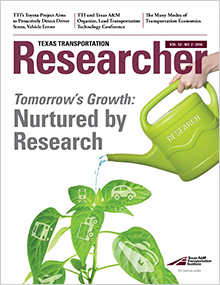Building and maintaining Texas’ transportation infrastructure are costly endeavors. Research conducted by the Texas A&M Transportation Institute’s (TTI’s) Infrastructure Investment Analysis Program (IIAP) helps inform policy makers how best to mitigate those costs and provide the greatest return to Texas taxpayers.
“The importance of transportation to the economy is obviously significant,” says IIAP Manager David Ellis. “But it doesn’t just entail funding highways; it cuts across all types of transportation modes.”
Ports

As part of one of the largest port systems in the United States, Texas ports play a vital role in the state’s total economic activity. For example, Port Freeport, which handled over 19.7 million short tons of cargo in 2013, generates significant dollars for Texas. To better understand the port’s contribution, TTI researchers examined its major stakeholders, key economic impacts and state funding for Texas ports, as well as the port’s history, defining characteristics and current development.
“We created an economic impact study of the port by looking at outputs such as jobs created, indirect income as a result of job creation, economic activity and tax revenue,” says TTI Assistant Transportation Researcher Brett Huntsman.
These data were used in a model to determine the economic impacts of the port’s operation. Researchers presented the results of the analysis to Port Freeport’s Board of Commissioners.
“The analysis numbers we showed them revealed significant growth at the port,” says Huntsman. “They were very pleased with our results and the transparency we offered as a transportation agency to achieve those results.”
Transit

Dallas Area Rapid Transit (DART) is the largest light-rail system in the southern United States by ridership. The sprawling system includes 90 miles of infrastructure that serves 62 stations in Dallas and 12 surrounding cities that pay for the service using a 1 percent sales tax revenue.
TTI researchers developed a web-based model for DART that provides macro-level estimates of the potential economic impacts and benefits associated with opening new DART stations to increase the service agency’s area. These impacts include the additional property tax revenues, sales tax revenues, employment and economic activity associated with the development of each new station.
“The model was created to provide a cost/benefit analysis for cities that want to become part of the DART network but do not have the available sales tax to pay for it,” says TTI Research Scientist Jeff Borowiec. “For many cities, this money simply isn’t available. This model allows prospective cities to examine other funding options such as the use of 4a or 4b tax money, which is still sales tax revenue but is limited to economic-development-related uses. Our tool gives them the ability to input known factors and view the costs and potential economic benefits that would come to their city and region.”
Highways

Given so many highways to maintain with limited funding, project prioritization is of major importance to the Texas Department of Transportation (TxDOT). TTI Assistant Research Scientist Brianne Glover recently led a cost/benefit analysis project on roadway segments. Her team’s goal was to provide TxDOT with information to help the agency prioritize certain projects based on each one’s potential return on investment.
“Each district has a map of projects under consideration,” says Glover. “We took each project and evaluated such factors as safety benefits, vehicle operational cost savings, business output and other factors to provide a benefit/cost ratio to determine which projects to prioritize.”
The team also researched the economic impact of expediting projects in rural areas. Researchers conducted two case studies involving the development of mobility projects in rapidly growing small urban areas in Texas. The first case study reports on the expansion of a parkway that connects a fast-growing industrial park with important north-south routes around Odessa, Texas. This project was selected in part because of its importance to the region’s oil and gas sectors.
“The John Ben Shepperd Parkway overpass at Business 20 opened up an additional entrance into Odessa from I-20,” explains Tracy Jones, economic development specialist at the Odessa Chamber of Commerce. “This new gateway into the community spurred the location of Standard Sales Company’s $16 million wholesale distribution center, West Texas Food Bank’s $8 million regional distribution center, Saulsbury Industries’ corporate headquarters and the construction of several new hotels.”
Pipelines

Though drilling in the Eagle Ford Shale region has slowed recently, the practice of hydraulic fracturing (i.e., fracking) still results in increased levels of truck traffic. Shale-related energy production causes an estimated $2 billion annually in damage to Texas roads, with $1.3 billion of that occurring on roads in the Eagle Ford Shale region alone. This damage is primarily caused by trucks hauling water necessary for the drilling and fracking process.
TTI researchers have investigated the efficacy of using seawater desalination combined with a pipeline network to distribute the water to the users instead. The project was funded by The Texas A&M University System’s Area 41 Institute, the mission of which is to “foster and support collaborative research and education across The Texas A&M University System on critical issues facing the state of Texas and the nation in the next three decades.”
“We’ve looked at the economic viability of building a desalination plant along the Texas coast and then building a network of pipelines that would bring the water to within a mile or two of the wells,” says TTI Assistant Transportation Researcher Max Steadman. “Our goal is to reduce truck traffic by 40 percent. In addition to fracking, the water can also be used to meet agricultural or municipal needs. The cost/benefit to the state in reduced road damage could potentially be several hundred million dollars per year.”
